A scientific journey in northern Finland
Dr. Logan Berner
Postdoctoral Researcher
School of Informatics, Computing, and Cyber Systems
Northern Arizona University
The northern Finnish state of Lapland was burned to the ground by the Nazis during World War 2, but those dark days have passed in these northern lands where for the last 15 years two friends from these previously warring counties have brought together international groups of researchers and students in the spirit of scientific investigation and education. Professors Timo Kumpula (University of Eastern Finland) and Benjamin Burkhart (Hannover University; Figure 1) have been studying the ecosystems and cultures of northern Lapland for several decades, as well as leading field courses to train Finnish and German geography graduate students in various field techniques. Thanks to the G2P2POP Research Coordination Network, I had the opportunity to join this team in 2019 to learn more about northern ecosystems and cultures, as well as develop new colleagues and field skills, thus broadening my potential research as a terrestrial ecologist.
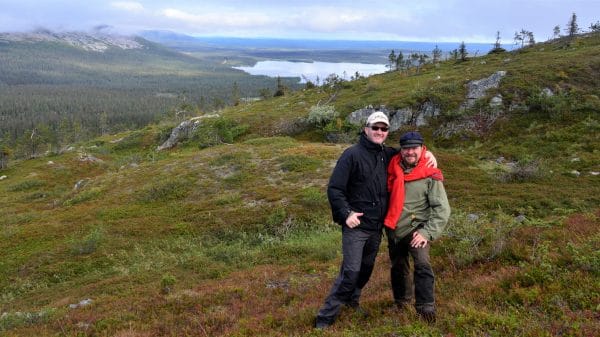
Finland is a fairly flat, sparsely populated expanse of boreal forest, wetlands, and lakes, with tundra in the north (Figure 2). Forestry is big business in the country and the southern forests of Finland are among the most intensely harvested of any in the boreal forest biome. The northern forests of Finland were long utilized for both timber harvest and reindeer herding, but these forms of land use came into bitter conflict as industrial logging cleared old-growth forests that provide critical wintertime lichen
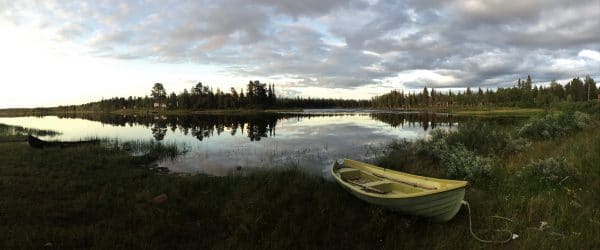
The Kilpisjärvi Biological Station is nested into a picturesque open mountain birch forest beside a large lake and provided a home-based as we worked in the surrounding area for six days. Much of this team’s ongoing research in the area focuses on monitoring and mapping the size and structure of palsas (Figure 3), a type of cryogenic permafrost landform that is rapidly disappearing from Finland as the climate warms. Specifically, a palsa is a small mound, perhaps several meters tall, that has a core of ice and is often overlain by peat. Palsas typically occur in northern mires—a kind of boggy wetland—and are likely the last form of permafrost in Finland. The team has been monitoring and mapping palsa characteristics across a network of sites in the country using cutting-edge techniques, including drones, terrestrial laser scanners, and other methods. This ongoing monitoring has documented regional shrinking and disappearance of palsas as their icy cores melted with each passing summer in recent decades.
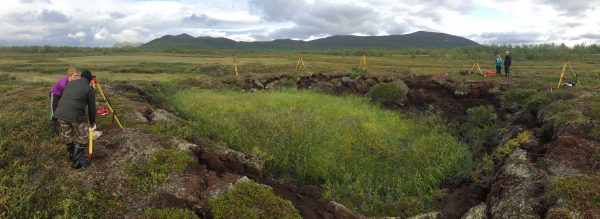
Rising air temperature are not only thawing permafrost in northern regions (e.g., Biskaborn et al. 2019) but are also affecting plant communities in tundra ecosystems (e.g., Bjorkman et al. 2018). For instance, multiple lines of evidence show that shrubs are growing larger and expanding into previously shrub-free areas in many regions (Tape et al. 2006, Ropars and Boudreau 2012, Frost and Epstein 2014). I’ve been involved with mapping shrub biomass across northern Alaska using satellites (Berner et al. 2018) and developing techniques to quickly estimate shrub biomass in the field using measurements of stem basal diameter (Berner et al. 2015). Based on hundreds of individual shrubs harvested in northern Siberia and Alaska, we previously found that stem basal diameter was a strong predictor of total shrub dry aboveground biomass, yet the relationship between basal diameter and biomass differs among shrub genera and by region within shrub genera. Consequently, our team’s visit to Lapland provided a unique opportunity to collected shrubs from this region. With help from several students (Figure 4), I was able to harvest, dissect, dry, and weight 65 willow (Salix spp.) and dwarf birch (Betula nana) from four locations, thus expanding the increasingly pan-Arctic database of shrub allometry measurements. While lacking the high-tech luster of terrestrial laser scanners and drones, these allometric measurements will provide a tool that ecologists can use to help quantify and monitor changes in an important aspect of tundra plant communities.
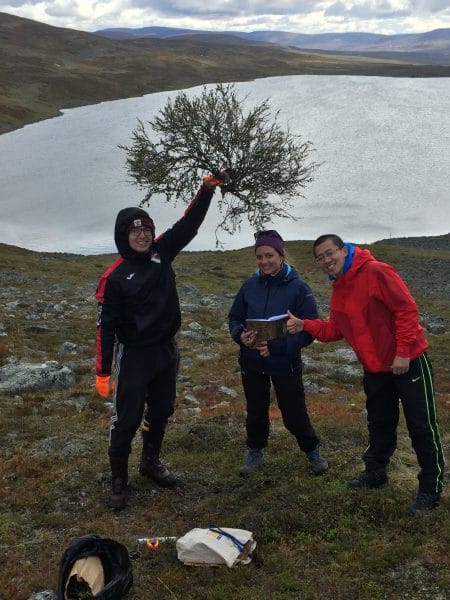
After the 10-day field course and a brief visit and presentation to the University of Lapland’s Arctic Center, it was time to head back to USA. The trip provided an opportunity to see semi-domesticated reindeer in the birthplace of Santa Clause (Figure 5), but more importantly it yielded new friends, a better understanding of northern ecosystems, more shrub allometry data, and exposure to emerging techniques for mapping and monitoring ongoing landscape transformations in northern regions.
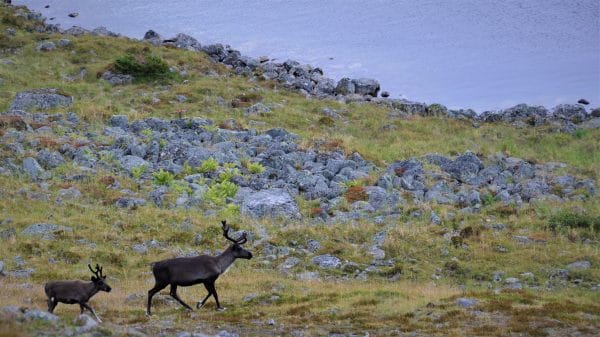
Literature cited
Berner, L. T., H. D. Alexander, M. M. Loranty, P. Ganzlin, M. C. Mack, S. P. Davydov, and S. J. Goetz. 2015. Biomass allometry for alder, dwarf birch, and willow in boreal forest and tundra ecosystems of far northeastern Siberia and north-central Alaska. Forest Ecology and Management 337:110-118.
Berner, L. T., P. Jantz, K. D. Tape, and S. J. Goetz. 2018. Tundra plant aboveground biomass and shrub dominance mapped across the North Slope of Alaska. Environmental Research Letters 13:035002.
Biskaborn, B. K., S. L. Smith, J. Noetzli, H. Matthes, G. Vieira, D. A. Streletskiy, P. Schoeneich, V. E. Romanovsky, A. G. Lewkowicz, and A. Abramov. 2019. Permafrost is warming at a global scale. Nature communications 10:264.
Bjorkman, A. D., I. H. Myers-Smith, S. C. Elmendorf, S. Normand, N. Rüger, P. S. A. Beck, A. Blach-Overgaard, D. Blok, J. H. C. Cornelissen, B. C. Forbes, D. Georges, S. J. Goetz, K. C. Guay, G. H. R. Henry, J. HilleRisLambers, R. D. Hollister, D. N. Karger, J. Kattge, P. Manning, J. S. Prevéy, C. Rixen, G. Schaepman-Strub, H. J. D. Thomas, M. Vellend, M. Wilmking, S. Wipf, M. Carbognani, L. Hermanutz, E. Lévesque, U. Molau, A. Petraglia, N. A. Soudzilovskaia, M. J. Spasojevic, M. Tomaselli, T. Vowles, J. M. Alatalo, H. D. Alexander, A. Anadon-Rosell, S. Angers-Blondin, M. t. Beest, L. Berner, R. G. Björk, A. Buchwal, A. Buras, K. Christie, E. J. Cooper, S. Dullinger, B. Elberling, A. Eskelinen, E. R. Frei, O. Grau, P. Grogan, M. Hallinger, K. A. Harper, M. M. P. D. Heijmans, J. Hudson, K. Hülber, M. Iturrate-Garcia, C. M. Iversen, F. Jaroszynska, J. F. Johnstone, R. H. Jørgensen, E. Kaarlejärvi, R. Klady, S. Kuleza, A. Kulonen, L. J. Lamarque, T. Lantz, C. J. Little, J. D. M. Speed, A. Michelsen, A. Milbau, J. Nabe-Nielsen, S. S. Nielsen, J. M. Ninot, S. F. Oberbauer, J. Olofsson, V. G. Onipchenko, S. B. Rumpf, P. Semenchuk, R. Shetti, L. S. Collier, L. E. Street, K. N. Suding, K. D. Tape, A. Trant, U. A. Treier, J.-P. Tremblay, M. Tremblay, S. Venn, S. Weijers, T. Zamin, N. Boulanger-Lapointe, W. A. Gould, D. S. Hik, A. Hofgaard, I. S. Jónsdóttir, J. Jorgenson, J. Klein, B. Magnusson, C. Tweedie, P. A. Wookey, M. Bahn, B. Blonder, P. M. van Bodegom, B. Bond-Lamberty, G. Campetella, B. E. L. Cerabolini, F. S. Chapin, W. K. Cornwell, J. Craine, M. Dainese, F. T. de Vries, S. Díaz, B. J. Enquist, W. Green, R. Milla, Ü. Niinemets, Y. Onoda, J. C. Ordoñez, W. A. Ozinga, J. Penuelas, H. Poorter, P. Poschlod, P. B. Reich, B. Sandel, B. Schamp, S. Sheremetev, and E. Weiher. 2018. Plant functional trait change across a warming tundra biome. Nature 562:57-62.
Frost, G. V., and H. E. Epstein. 2014. Tall shrub and tree expansion in Siberian tundra ecotones since the 1960s. Global Change Biology 20:1264-1277.
Ropars, P., and S. Boudreau. 2012. Shrub expansion at the forest–tundra ecotone: spatial heterogeneity linked to local topography. Environmental Research Letters 7:015501.
Tape, K., M. Sturm, and C. Racine. 2006. The evidence for shrub expansion in Northern Alaska and the Pan-Arctic. Global Change Biology 12:686-702.